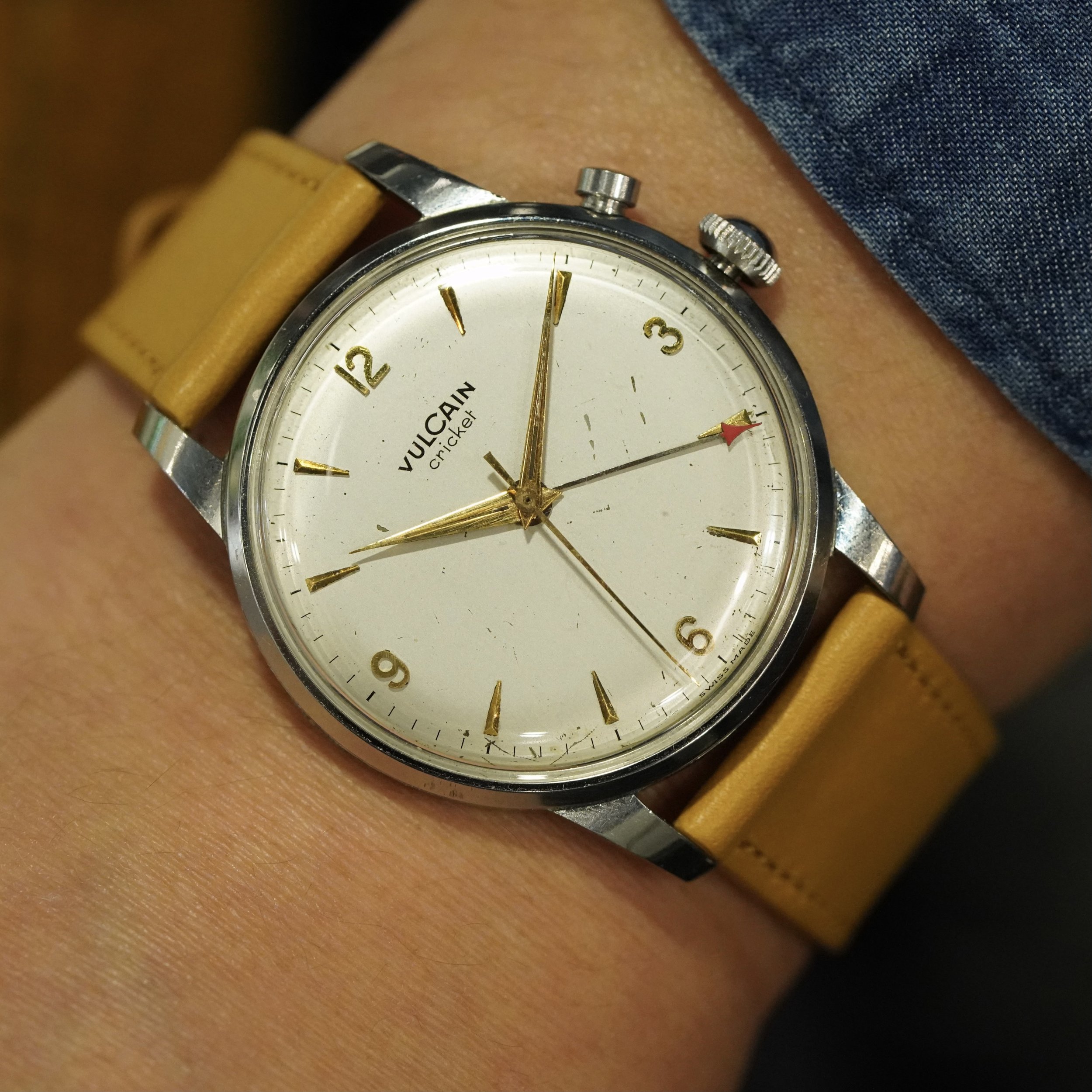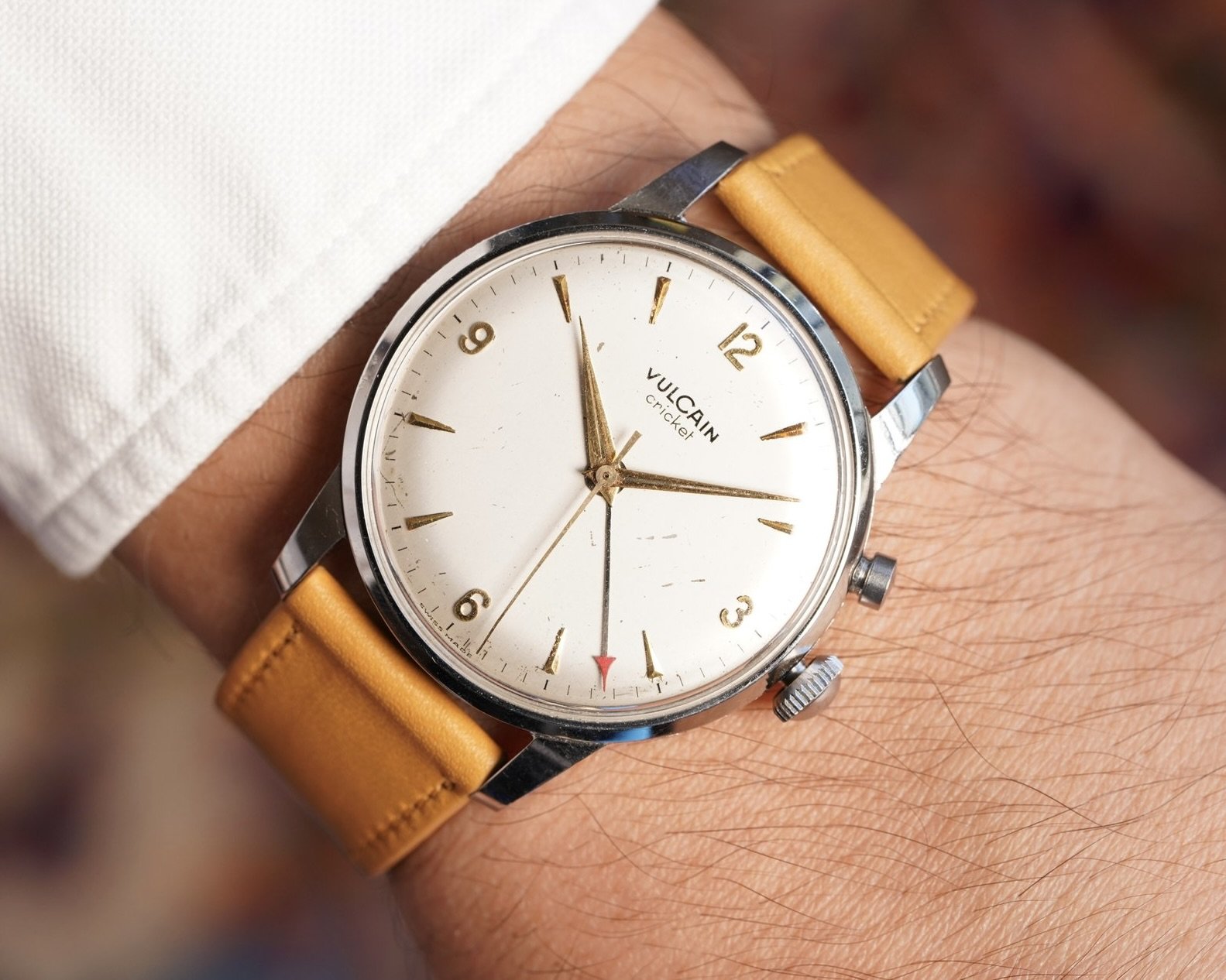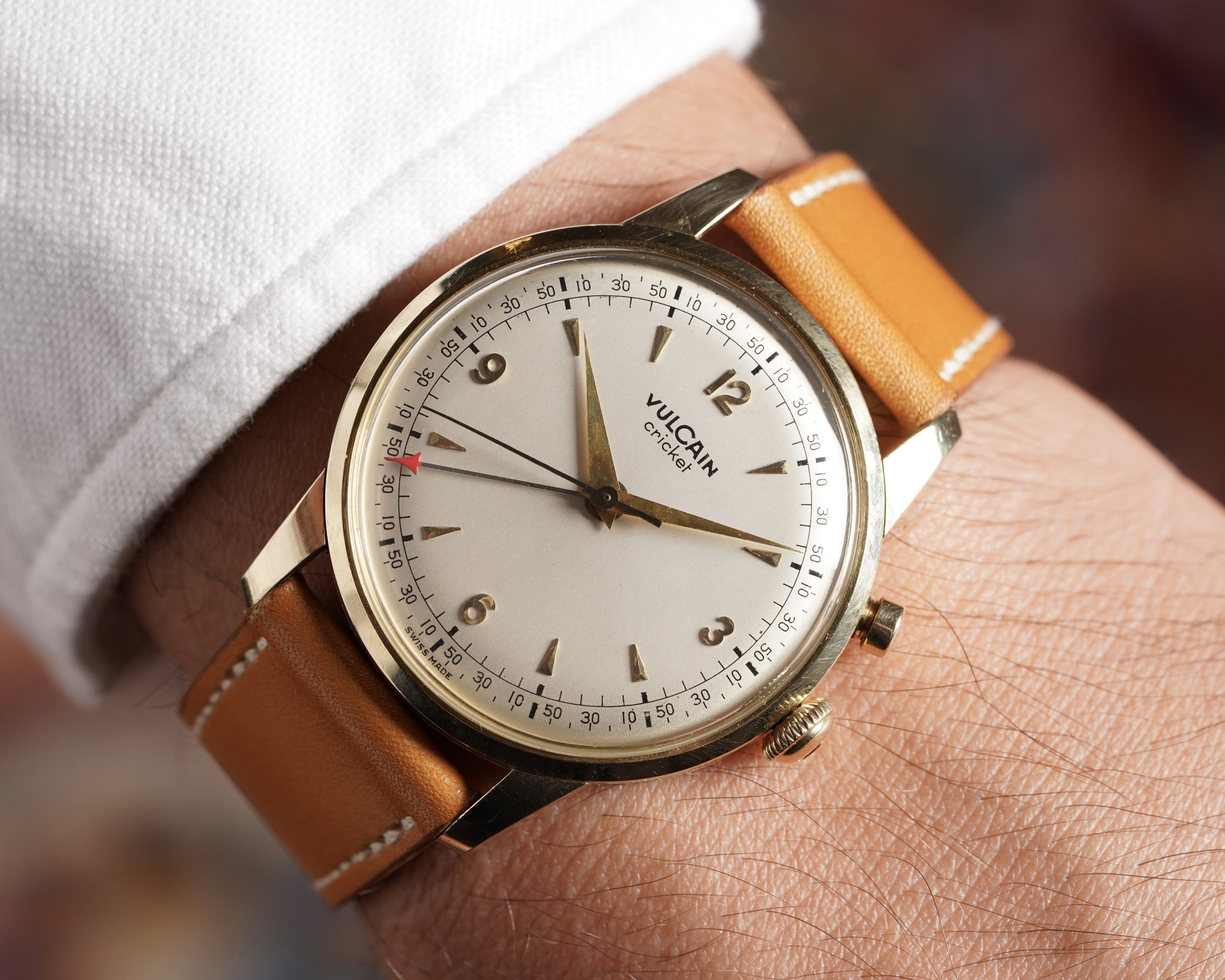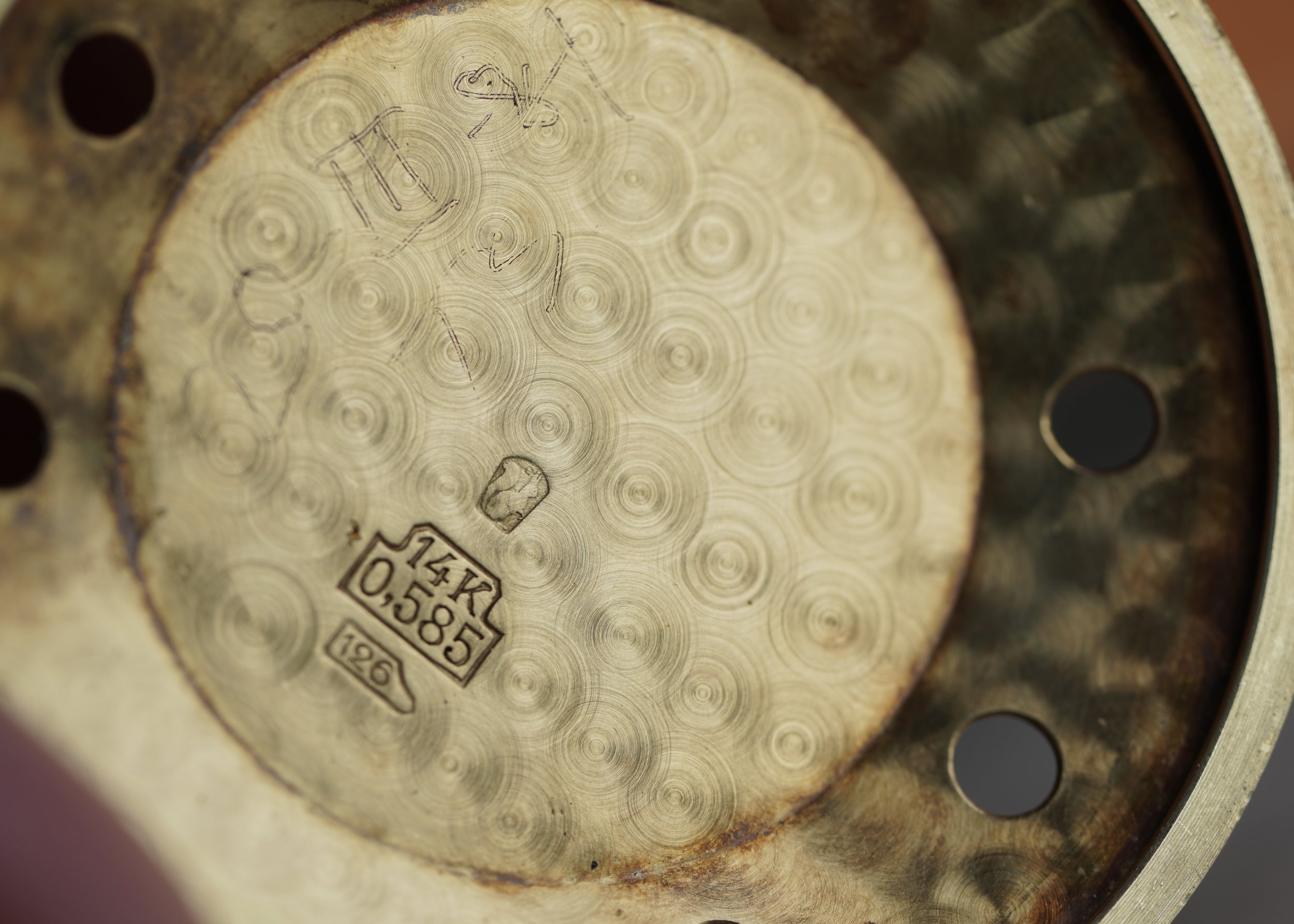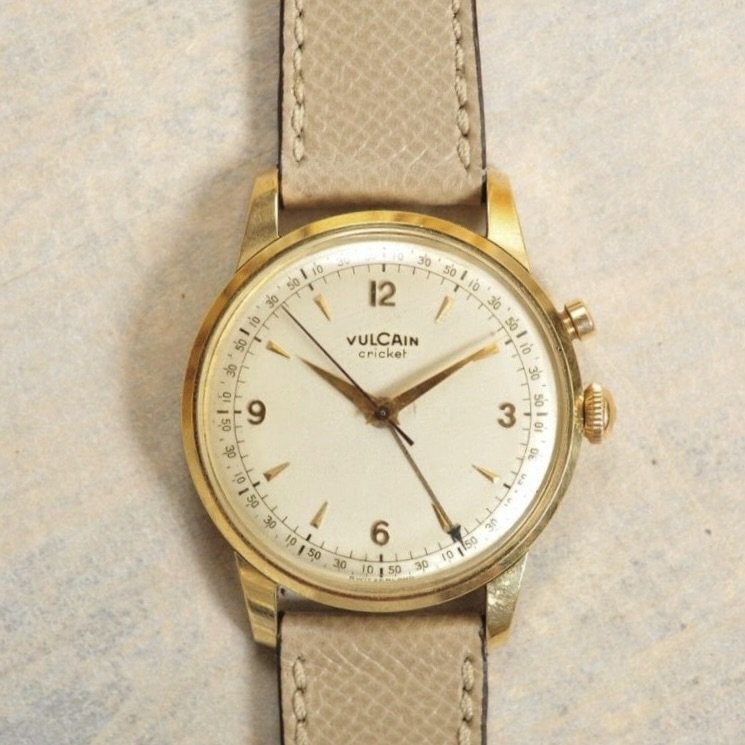Jumbo Vulcain Crickets: The References 301001 and 303001
By Charlie Dunne
The Vulcain Cricket is an iconic wristwatch. It was the first commercially produced alarm wristwatch, and for many years it enjoyed unrivaled success and press. Like many important watch models, the Cricket is even on view in The British Museum (artifact number 1989,0407.2). Having collected a number of Crickets since my first example, an LBJ dial I purchased in 2021, I’ve come to consider these alarm watches to be among the coolest watches I’ve ever encountered - regardless of brand. Unfortunately, modern interpretations leave a great deal to be desired in both quality and aesthetic. Furthermore, the brand’s official website is riddled with misspellings and inaccuracies leaving many to wonder how this great timepiece has fallen so far from grace. I am excited to expand upon two references that have stood the test of time and represent the epoch of the brand: the oversized or “Jumbo” Vulcain Crickets references 301001 and 303001.
Vulcain Cricket “Jumbo” reference 301001 in gold and then reference 303001 in steel.
The Large “Jumbo” Vulcain Cricket Cases
What makes these oversized Crickets particularly exciting is their cases. These, along with the similar oversized “King Cricket” reference 303002 that is part of the same family, but has stepped lugs, are among the largest cases of the 1950s Crickets. They measure 38mm in diameter (or 46mm lug-to-lug) which is generally uncommon for mid-1950s timepieces and they wear fantastic on the wrist due to the robust case and 20mm lug width. However, they have a relatively slender height at 11mm and feature a domed case back used to amplify the alarm through the metallic membrane. Each model is equipped with the calibre 120. This was the first mass-produced alarm wristwatch movement and to this day it remains an extremely reliable movement, and it is nothing short of an iconic watch.
One theory behind the size is that they were in fact oriented for commercial pilots - a detail given within advertisements from the period. The alarm complication was incredibly practical for the commercial airline pilots in the 1950s which is a detail largely overshadowed by Rolex designing the GMT-Master specifically for Pan Am pilots in 1954. In addition, the larger or sportier cases appear within marketing material focused around the Italian alpinists who summited K2 in 1954, Nevertheless, these oversized models would be produced in rather small quantities before Vulcain’s focus transitioned to the more compact “Waterprotected/Waterproof” S Series cases in the following years.
Image credit: hifi-archiv.info
Different Dial Variations
What makes the 301001 and 303001 models a bit more straight forward is that the dials and cases rely on each other, whereas OG cases, dials, and movements are frequently swapped into waterprotected models (and vice versa) for aesthetic reasons. Instead, these larger dials cannot be swapped around in Crickets as they are inaccessible. Most dial layouts incorporate the applied-hours at 3,6 9, and 12 with dagger markers. These tend to have the “thick font” Vulcain printed seen in LBJ dials (albeit with slightly wider kerning).
Image credit: hifi-archiv.info
Image credit: hifi-archiv.info
There are also variants with the applied Vulcain branding. These will incorporate different numerals and arrow markers. The rarest variants appear to be the luminous dauphine examples which also appear in the “King Cricket” ref 303002. More often dials will feature 10, 30, and 50 demarcations for setting the alarm, while others will simply have painted minute markers.
Gold examples of the reference 301001 are extremely rare. Finding them in exceptional condition is very difficult and these will feature a gold membrane. The interior of the case back will feature a Poinçon de Maître No.1 (hammer head hallmark) with the number 126. This indicates the maker of these cases was Jean Humbert & Co. S.A - a case maker also based in La Chaux de Fonds.
Collecting Jumbo Crickets
I would estimate that far fewer than a hundred of these oversized Crickets from the 1950s are known, but many are not in collector-grade condition. In comparison, many “rare” Patek Philippe references have hundreds of examples publicly known.
These examples have very interesting details in their own right. Whether it be small nuances like black vs. red alarm triangles, or signed or unsigned crowns. I manage to find interesting details on Crickets after years obsessing over them, more recently finding out that a one of my personal watches was a chronometer with a numbered movement! Perhaps one of my favorites comes in the form of examples bearing up to five of Robert Ditisheim’s patents on both the movement and case. As far as I recall, I have yet to see another vintage watch with this many patents represented on the case/movement. Below are the five patents and their corresponding drawings.
US Patent 2,554,402 (1951)
The first patent “relates to an alarm watch comprising a single winding-up and hand-setting crown, the hand-setting and the setting of the alarm hand of which are effected by rotating the winding-up crown. The alarm watch according to the invention is characterised by such safety means that a mistake by the user can cause no damage to the mechanism. The safety means employed especially are designed to avoid the creation, by misuse, of a discrepancy between the hour indicated by the alarm hand.and the actual time of the releas.e of the alarm by- the release mechanism.” The drawings represent a pocket watch that appears to be the prototype timepiece Ditisheim began with. It was applied for a patent on April 20, 1943 and it would eventually be patented on May 22, 1951.
US Patent 2,568,795 (1951)
The second patent “relates to an improved alarm locking device of particular utility in an alarm wrist watch. In ordinary alarms, the locking of the alarm mechanism is usually achieved by introducing a pin, or a point, into the trajectory of a member having a reciprocating motion. In most cases this member is constituted by either the anchor or the hammer of the alarm mechanism. The movable member can then be stopped by the pin either on one or the other side of the latter, the pin interrupting the path of travel of the member and excluding it from access to a part of its trajectory. The excluded part of the trajectory is situated on one or the other side of the pin according to the position of the movable member at the instant when the pin is set in its locking position. This known type of locking device has the disadvantage of permitting the movable member (anchor or hammer) to continue to oscillate through that part of its trajectory which will bring the haffimer into contact with the sounding mechanism as the result of moving or jolting the time piece. This condition occurs when,(a) the alarm mechanism is run down, and (b) the locking member or pin has happened to engage the movable member in one of two possible parts or segments of its trajectory. When this occurs there is no way definitely to shift the movable member to the other side of the locking pin while the latter is in locked. position.
A principal object of the present invention is the provision of a locking member controlling the alarm mechanism, which, when in locked position, excludes the movable member (anchor or hammer) from a selected or definite part of its trajectory. According to the invention as provided for an alarm watch having a hammer acting on a s ' ounding member, the part of the trajectory selected for elimination may either correspond to the part of the trajectory of the said hammer in which the latter acts upon the sounding member in order to prevent the impact of the hammer upon the sounding member, or may correspond to another part of the trajectory of the said hammer which ensures that the remaining travel of hammer will not be sufficient for action of the hammer on the sounding member to cause an 5o, audible vibration. The watch can then be shaken without this resulting in the production of sound, even when the spring.of the alarm mechanism is run down. In a preferred embodiment of the invention, 2 the alarm mechanism comprises an anchor escapement driving a hammer which is integral with the said anchor. The locking member is constituted by a locking lever the extremity of which: is situated, when in locking position, in the trajectory of either the hammer or the anchor, in order to form a stop which holds the said member in one direction but allows it to pass in the other direction. This result is obtained by giving the lever a shape designed to cause the extremity of the said lever to be elastically repelled by the movable member out of its trajectory when the said member moves in this latter direction, inclined cam-surfaces being provided on the movable member and on the locking member in order to facilitate the passage of the movable member.
The drawing shows, by way of example, two embodiments of the locking mechanism of a watch object of the invention, comprising a hammer driven by an anchor escapement and also, for comparison, a known form of such a mechanism.” It was applied for on July 17, 1948 and eventually patented on September 25, 1951
US Patent 2,644,294 (1954)
The third patent is for the perforated case back and inner membrane which is “audible to the human ear. The diaphragm is furthermore designed to occupy the least space possible in the direction of thickness of the watch, to provide a dust proof inner-cover for the mechanism, and at the same time to provide the inner wall of a resonant chamber in conjunction with the outer back cover. [The} back cover [is} designed in conjunction with the diaphragm beneath, a resonant chamber of the maximum diameter possible [to enhance] the alarm sound which means cannot be muffled by the wrist of the wearer. By reason of the selected design, these objects are attained while avoiding a distorted or bulky appearance at the back of the watch, and without adding objectionably to its thickness.
The size and shape of the chamber are attuned to the vibrational rate of the diaphragm to provide maximum amplification of the sound vibrations. A separate alarm spring and special connecting and driving means with the hammer to insure rapid oscillation of the latter, together with- means for releasing and turning off the alarm.”
It was applied for on April 24, 1952 and patented on December 2, 1954.
German Patent 920,958 (1954)
“The idea of designing an ordinary, wearable utility watch as an alarm clock is not new. A men's pocket watch has already been described with a membrane protected from mechanical damage by two perforated protective bases, which is deformed in quick succession by means of a pin periodically bent out by a rapidly rotating toothed wheel and is thereby set in vibration. The efficiency of this noise device is very low, mainly because the membrane cannot vibrate freely; each vibration is brusquely dampened when the next spike hits the membrane pin and the vibration energy is converted into useless mechanical work. This also results in rapid wear of the rubbing parts and also in the need for a strong and therefore bulky mainspring for the alarm mechanism.
In view of these facts, it is not surprising that technology took different paths in the development of the alarm wristwatch, where the space available for accommodating the mechanical energy store is even more limited than in a pocket watch.
The first alarm wristwatch proposals made use of bell shells or gong sticks set in motion by a mechanical link. The achieved volume of such chimes derived from the normal alarm clock noise was far too low for practical use. In addition to these attempts to transfer known chimes to a wristwatch in a smaller version, the so-called touch alarm clocks were also described several times, i. H. Wristwatches which, instead of acoustic organs, have mechanical means of scratching, piercing or vibrating directly on the skin of the wearer of the watch. All of these proposals did not meet the wishes of the public, so alarm wristwatches have practically not appeared on the market to this day.
The invention now shows a way of avoiding the described disadvantages of the alarm wristwatches previously produced. This is made possible by the combination of the following features: a) a membrane excited by an attachment serves as the sound organ, which tightly seals the movement case and is mechanically protected against accidental sound-dampening contact; b) the membrane is made to vibrate by a hammer.
Taken individually, these characteristics are known in principle. As mentioned at the beginning, the first of the two features has already been proposed for a pocket watch, while feature b) has already been used in a table clock. Numerous tests confirmed the correctness of the considerations of the author of the present invention and confirmed that the combination of the two characteristics known from other watches in a wristwatch satisfactorily solves the problem that has existed for a long time, in that the new watch is characterized by a large volume and long ringing time , with practically the same dimensions and appearance as an ordinary wristwatch.
It is advisable to position the direction of vibration of the hammer parallel to the plane of the movement and to provide the membrane with a stop pin, similar to the pocket watch mentioned. Only in clocks that are equipped with gong rods or bells to generate the sound waves is it known to swing the hammer parallel to the plane of the movement.”
The fourth patent was applied for on September 6, 1944 and patented on December 2, 1954.
German Patent 932,420 (1955)
“Anchor-bevel drive for the alarm hammer in alarm wristwatches The subject matter of the invention is an anchor-bevel drive for the alarm hammer in alarm wristwatches. In these drives, the armature interacting with the pitch wheel and the hammer striking the sounding organ have hitherto always formed a rigid unit. It has now been found that the hammer, which is in rigid operative connection with the armature, when striking the vibratory organ, i. H. the diaphragm or the like, does not produce a full, lingering bell tone, but rather tones that are very short and muffled. This is because the hammer is prevented from freely swinging back immediately after striking the tone organ. This is not possible because the hammer is rigidly connected to the armature and is therefore briefly stopped in its two extreme positions. The result of this is that the hammer rests on the tone organ for a short time and thus prevents it from vibrating freely. For these reasons, it is not possible to produce an insistent and full chime with the known anchor pitch wheel drive for an alarm hammer. A further disadvantage of the cited anchor pitch wheel drive is that the rigid hammer with its relatively large weight can have unfavorable repercussions on the sensitive anchor or on the pitch wheel cooperating with this when braking suddenly, because parts of this anchor may open quite abruptly the teeth of the ascending wheel can hit, which can even lead to damage. These disadvantages are avoided in the armature pitch wheel drive according to the invention, that the armature is not rigid, but is connected to the hammer by a pin or the like, which in turn is attached to the hammer and on the other hand engages in an opening of the armature which is dimensioned in such a way that the hammer can swing freely within certain limits. It is particularly expedient to arrange the armature and the hammer so as to be rotatable about the same axis and to provide the hammer with a pin with which it engages with play in an opening in the armature. This design of the drive means that the hammer receives an impulse accelerating the hammer through the armature for each strike of the sounding organ (membrane etc.), but that the hammer is released from the armature before it hits the sounding organ , so that it is struck only briefly. The consequence of this is that the kinetic energy is largely converted into sound energy. The arrangement has an extraordinarily high level of efficiency and allows an easily audible tone to be produced with a relatively small drive spring. The advantages of the invention for alarm wristwatches are therefore obvious.”
The final patent was applied for on February 16, 1950 and patented on September 1, 1955.
A Final Word
These oversized or “Jumbo” Vulcain Crickets are some of the most interesting and wearable vintage Cricket models, but their interest should be far wider than that. Collectors of oversized vintage time-only and chronograph models, such as vintage Longines, Breitling or Universal Genève collectors, often have not had the chance to see one of these rare models in person, but when they do, it is not unusual to hear an audible gasp or at least eyes widening when they try it on their wrist. Both Eric Wind and I have Jumbo Crickets in our collection and find them eminently wearable. I hope you will have the chance to see one of these in person one day and perhaps have the special opportunity to add one to your collection.


